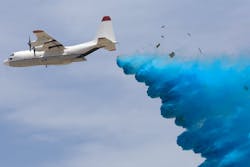PCADS: A Military Solution to Wildland Firefighting
An Alternative Solution
PCADS (Precision Container Aerial Delivery System) is the brainchild of William Cleary, an Advanced Systems Project Manager at Boeing Aerospace’s Long Beach facility. Cleary got the idea from dropping water balloons off a rooftop. “What we’re doing with PCADS is airdropping on wildfires,” he explains. “For a long time now, the Department of Defense has tried to improve how you deliver something to the ground, such as supplies to our warriors, and how you do it accurately.
“With PCADS, we are taking advantage of all the technology that is applied to airdrops today,” he continues. “What we found is that by using the aircraft technology, meaning GPS in the aircraft and computers that can measure wind and other factors way beyond GPS, we’re able to be extremely accurate with these PCADS.”
PCADS Revealed
So what exactly is a PCADS unit? It is a 250-gallon plastic bag surrounded by a cardboard box and mounted on a skid. The units are loaded into the cargo bay of a transport aircraft, then a pilot simply flies to the GPS coordinates of the fire and the loadmaster deploys the bundles out the back of the aircraft at a safe altitude.
“What we’ve done with PCADS is to design them around the military system called CDS (Container Delivery System), so our 2,000 pounds fits that system perfectly,” Cleary explains. “We had to design PCADS so that it met an Air Force requirement, but we also had to create a scenario where it came apart when it got into the airstream. Because we use a CDS rigging system, we don’t have to use straps on PCADS.” As a result, the parts all separate on leaving the aircraft, with the oversized top acting like a parachute, and pieces that are like razor blades that are connected to the rigging with a lanyard, so that these razor blades cut the rigging.
“What we’ve done lately is that we’ve replaced those razor blades with a timing device that delays the cutting of the rigging at a pre-set time – 10 seconds, 4 seconds, etc. – to delay the time that PCADS bursts,” Cleary adds. “This allows the aircraft to drop from a higher altitude [than a conventional air-tanker would drop].”
Military On-Board
Needless to say, the military is already adept at night-dropping cargo. “They have night-vision goggles, air-dropping requirements that they drop within certain distances at night, so we’re using the same crews who do the air-dropping for fighting fires,” explains Cleary. “What the IC [Incident Commander] has to provide the aircrew is latitude and longitude as to where you want PCADS.”
And the military is warming to the mission. “We’re now at a point where we’ll be working with the Air National Guard on the strategy and tactics for using PCADS on fires,” Cleary reports. “We’re very excited about the Air National Guard work because they have lots of ideas for PCADS and they have a requirement to fight wildfires.”
If you are concerned about difficult terrain, it is not a problem. “The good thing about this tactically is that it opens up opportunities that are not available right now [to air-tankers] because we can drop into a box canyon or a deep gorge,” PCADS team member and Wildfire Consultant Don Green explains. “There are so many different things this can do – we can drop on spot fires as small as a car fire. It expands the operational capability of aerial firefighting.”
Platform Diversity
Unlike purpose-built firefighting aircraft, PCADS isn’t picky what you use to drop it. “The other beautiful thing about PCADS is that it separates the system from the platform,” Cleary confirms. “There are multiple platforms that can use PCADS. We’ve been asked to test with the C-17, there are also military helicopters that have ramps, and the Italians have a C-27, which is a smaller C-130-type of aircraft.”
The Army National Guard isn’t the only outfit with C-130s. “We’ve also used Marine Corps C-130s, and a private company in Alaska that has C-130s as well,” Cleary reports.
The switchover from heavy-lift helicopters to the new MV-22 Osprey tilt-rotor aircraft at West Coast Marine bases provides another platform for PCADS. Lt. Col. Nash of the San Diego-based 3rd Marine Aircraft Wing passed along a press announcement via one of his wildfire aviators, Captain James Tiller, which states, “With the V-22 squadrons beginning to stand up, we would like to use them during the fire season.”
And military bases are everywhere! “There are Air National Guard assets in every state, including Alaska and Hawaii, along with already-qualified crews, so there’s a response-time benefit and a cost-benefit, too, because it’s very expensive to maintain aircraft used only for fighting fires,” says Cleary.
Proven Track Record
The PCADS team members have been frequent visitors to Yuma Army Proving Grounds in Arizona. “We’ve dropped over 300 units this summer, without any leaking on the aircraft,” reports Ty Bonnar, VP of Global Operations for Flexible Alternatives, a manufacturer that works with Boeing to provide engineering and operations for many of the PCADS parts. “In the last six months we’ve dropped over a half million pounds of cargo and delivered over 70,000 gallons of suppressant (water and gel) onto Army test drop zones.” Because of that delay device, team members can determine where it’s going to burst in the air. “We can extinguish spot fires with 16 PCADS like 16 [Type II] helicopters!” adds Green.
A Look Ahead
The U.S. isn’t the only country with wildfires, and for those without a heavy air-tanker fleet, PCADS could fill the gap, as Cleary points out. “Ten foreign countries are interested in PCADS right now, including Greece, Italy, and Argentina.”
One of the things they have been talking about is weather modification, especially at night, according to Cleary, when it might have a greater impact on the fire than anticipated. “The Air National Guard sees that too,” he says.
What is the Forest Service’s reaction to PCADS? “The Forest Service has been with us on most of our test drops,” reports Green. “Their primary concern was about the PCADS elements falling to the ground. We've accounted for the safety aspects of the falling elements by ensuring our operational parameters fit specific guidelines for use. PCADS will not only enhance firefighting capabilities, but actually make aerial dropping safer for the air crew and ground forces as well.”
But wildland firefighting is just one facet of what PCADS can do. “We’re a delivery system, so we’re constantly looking at different media, whether gel or water or retardant,” says Bonnar. And who knows where PCADS might pop up next?
MIKE ARCHER is an author, wildfire consultant, systems engineer, and public speaker who has been interviewed by CBS News, KABC-TV, USA Today, and the Associated Press on wildfire topics, and has been part of a delegation testifying before government bodies (including Congress and the California Senate) on fire-related issues. He runs the Wildfire News of the Day blog and Firebomber Publications.
About the Author

Mike Archer
Firehouse.com Contributor
MIKE ARCHER is an author, wildfire consultant, systems engineer, and public speaker who has been interviewed by CBS News, KABC-TV, USA Today, and the Associated Press on wildfire topics, and has been part of a delegation testifying before government bodies (including Congress and the California Senate) on fire-related issues. He runs the Wildfire News of the Day blog and Firebomber Publications.
